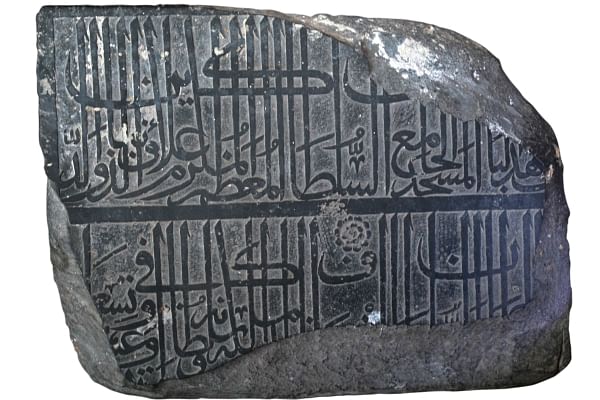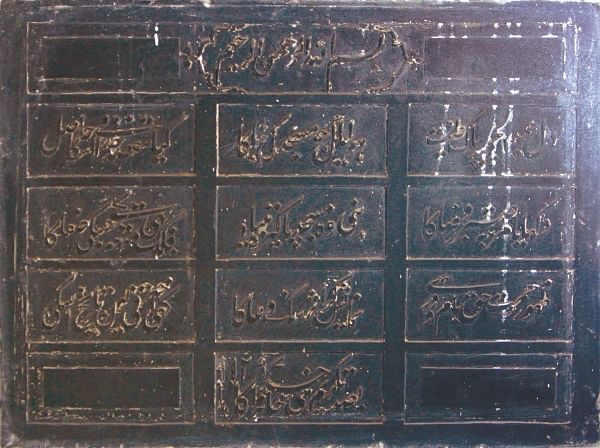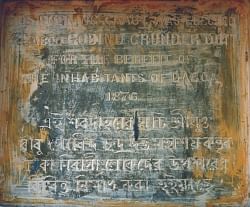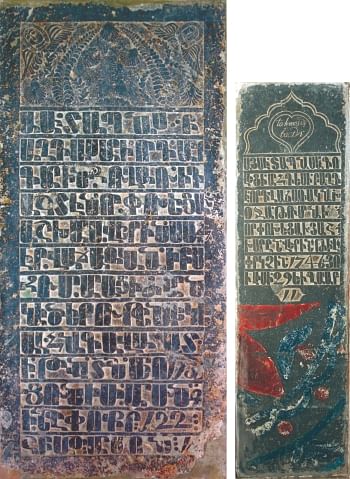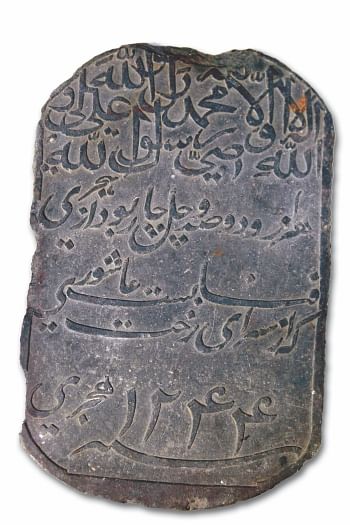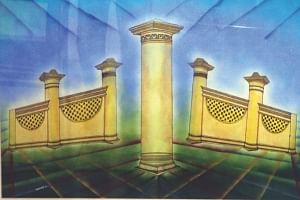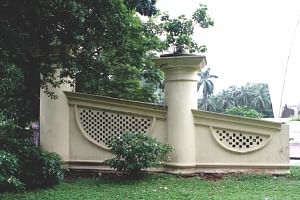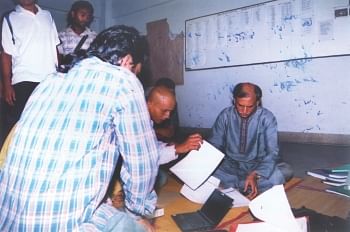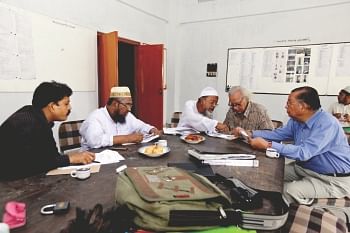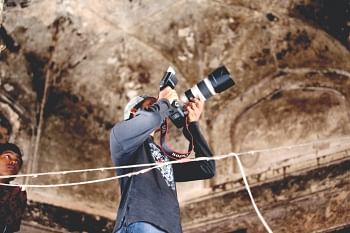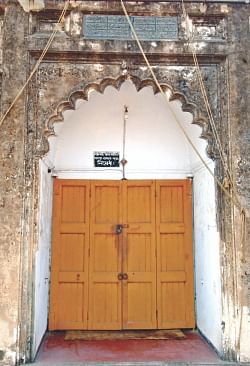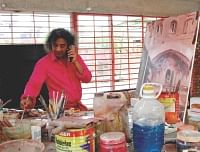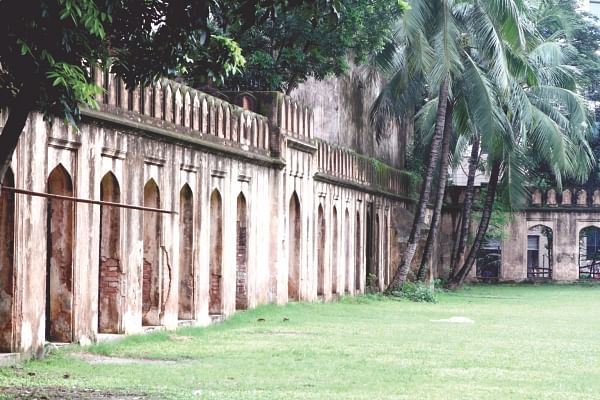| Home - Back Issues - The Team - Contact Us |
 |
| Volume 10 |Issue 28 | July 22, 2011 | |
|
|
Cover Story Decoding Ancient History A voluntary group, Committee for Documentation on Architectural Sites in Dhaka is searching and documenting Dhaka's history from inscriptions of architectural and historical sites.
Tamanna Khan In spite of its 400 years of glory, the history of Dhaka, like her patron goddess Dhakeshwari (concealed goddess), has its early history covered in mystery. Accounts of Dhaka's earliest settlers, life in the pre-Mughal periods or after the decline of the Mughals are obscure because of the lack of artefacts or evidence from the past.
In 2008, a group of young men and women from different disciplines and professions set out in search of these missing pieces. In the absence of written records, architectural sites provide historical clues about places and civilisations. “At first, our aim was to identify 100 oldest sites of Dhaka,” informs Joyeeta Roy, eminent photojournalist and convenor of the committee, “and publish a book on those sites.” Usually mosques, churches, temples, forts, palaces, bridges, graveyards, shrines, schools, madrasa and government offices escape population pressure and thus retain the residues of the past. Information about the date of establishment and builder are often engraved in their foundation stones or epitaphs of these structures or sites. With reference from books and journals, the group began to search every nook and corner of the city for historical sites and inscriptions. They soon realised that limiting their task to just 100 sites would not help complete the puzzle about Dhaka's history. So they formed the Committee for Documentation on Architectural Sites in Dhaka and sought help from journalists, photographers, historians, archaeologists, researchers, academicians, artists, cultural activists, religious scholars, linguists and students from different disciplines. Everyone consented to work on a voluntary basis.
Professor A A M S Arefin Siddique, Vice-Chancellor of the University of Dhaka (DU) and chief advisor of the committee says: “These young people coming from different disciplines like journalism, philosophy, realised that these inscriptions, which are very important elements and constituents of history, are getting lost. However, there is still time to research on these and publish the information. If this work can be done through a university, it will be easy to carry forward the task.” After formation of the committee under the patronisation of DU in August 2008, they decided to consolidate their findings in two sets of books — one to include information on architectural sites from pre-Mughal to Mughal period (1757 Common Era) and another from Mughal period (1757) to British period (1947). Each set will comprise of four volumes on — inscription, photography, painting and architectural design and drawing. The volume on inscriptions will include pictures of the inscription, the re-written script in the original language, the Bengali pronunciation of the script, its Bengali and English translation, description of the inscription stone and where it has been found, location of the architectural site, its present condition and so on.
The second volume will be a collection of all the paintings that have been drawn on Dhaka's architectural sites. According to a committee spokesperson, besides widely known paintings like Charles Doyle's, the volume will include paintings of Dhaka, present in paper notes, stamps and book covers. The committee members are collecting these works from books, museums, internet, Shilpakala Academy, art collectors and even renowned artists.
“We have found a painting of the Bara Katra by Shishir Bhattacharya drawn during his student life,” informs a member. Besides the existing paintings, the committee has requested prominent artists of the country to paint new pictures of architectural sites that they have newly discovered. So far 16 artists have submitted about 20 art pieces on Dhaka's architectural sites, informs the committee. The volume on photography will be unique because it will illustrate the evolution of Dhaka's historical architectural sites, by presenting photographs of the sites from different time periods. However, lack of photography images and demolition of the original buildings, may limit this collection especially for structures of the Mughal and pre-Mughal period. The last volume will entirely focus on architectural plans, elevation (a view of a building seen from one side) and section (vertical intersection of the building). The committee, with the help of an architectural team, will try to reproduce the designs. Twelve architects, including professionals and academicians, have consented to work on these designs, informs a member. Before starting the survey, the committee members divided Dhaka into ten regions. “We called one area the diplomatic zone. In Mughal Dhaka, Maghbazar was on the shores of River Norai, now the Kawran Bazar lake. Munipuripara, the Portuguese church, the English, French and Dutch kuthi (office) were in Tejgaon implying that during the Mughal period foreigners settled on the two sides of the River Norai. One area was a Mughal residential area. It was abandoned after the Mughals left and later occupied by Dhaka's Nawab family. That area was Azimpur, Dhaka University, Suhrawardy Uddyan and Motijheel. These places were jungles before the Mughals came and again turned into jungle after they left,” relates a member of the committee.
The committee members have gone through history books and from survey findings they confirmed the characteristics of these areas after consultation with historians. For instance the presence of a mosque indicates a residential area; reference of High Court being the aristocratic Mahallah-e-Chistiyan can be found in books. “Isa Kha's descendants and the Bengalis lived in Siddiqbazar, Alubazar, Nimtoli, Curzon Hall and in North South Road area,” he adds. Another region famous for Dhaka's Muslin, a very fine and loosely woven cotton fabric — the shores of Dholai River comprised of Demra, Narinda and Gandaria. Two areas have always been occupied throughout Dhaka's history — the shores of River Buriganga from Postagola to Lalbagh and the shores of Turag from Hazaribagh to Katasur. Centring on Shah Ali's Mazar, Mirpur forms another region while Keraniganj where the Jinjira palace is located forms the eighth area for survey. The eastern boundary of Dhaka on the shores of River Balu forms the ninth region where no inscription was found in old mosques. Tongi has been identified as the last and experimental segment as it shows signs of inhabitation only during Shayesta Kha's era. Most inscriptions have been found in the region from Chawkbazar to Farashganj, along the shores of Buriganga, informs a member.
One member relates the discovery of the inscription of the Babubazar or Islampur mosque. On their first visit, the mosque committee members could not give them any information. Next time they went inside the mosque and found the inscription lying against the wall on the second floor of the multi-storied modern mosque. The mosque committee members said that while digging up the foundation for the new construction, the workers' shovel made a thudding sound and after clearing the debris, they found the inscription.
The inscription has been found last year and among the unrecorded inscription the one found in Islampur mosque is the oldest. The oldest inscription (pertaining to Laksman Sen's era; 1178-1206 CE) found so far in Dhaka is that of Chandi Devi's temple. The inscription written in Sanskrit was first published in 1911 in the Journal of Asiatic Society of Bengal (JASB). Till the discovery of the inscription of the Islampur mosque, there has been a hundred years gap in the history of Dhaka. Shah Ali's Mazar built in 1480-81 is from Illiyas Shahi period. No record about the status of Dhaka after the decline of the Illiyas Shahi dynasty existed so far since the next recorded oldest inscription is that of Dhanmondi Eidgah built in 1640-41CE. The Islampur mosque provides evidence of human habitation in Dhaka and the Arabic inscription reads that the mosque was built in 1504-05CE and praises Alauddin Husain Shah. The inscriptions discovered by the committee are in different languages — Arabic, Persian, Portuguese, Armenian, Latin, English, Chinese, Urdu and Bangla. Translating inscriptions has been one of the most trying tasks for the committee. A team of 30 language experts comprising of university professors as well as religious scholars are working relentlessly in translating these valuable findings. Because of the nature of the language and translation technicalities, the chief advisor Professor Arefin Siddique has suggested that the committee seek help from the traditional schools of Arabic and Persian practitioners — scholars of the Kawmi and Alia Madrasa. Moulana Muhammad Nuruddin Fatehpuri, a scholar on Arabic, Persian and Urdu language and Imam and Khatib of Boro Bhat mosque, Lalbagh, says: “One of the main problems was that sometimes letters were missing or erased and could not be deciphered. Sometimes the words were covered by paints during new construction.” He often had to consult old dictionaries to look up the meanings of the words in the inscriptions. He explains that many of the words in Persian are no longer used in Iran, thus modern language experts are not familiar with them.
Finding a translator for Armenian language discovered in epitaphs of Tejgaon church has been a big challenge for the committee. The only Armenian left in Bangladesh has long forgotten the old language and the committee failed to find any help on the issue from the other European cultural centres. Fortunately, Father Silvano Garello, of Xaverian House, Mohammadpur, who has been translating Latin inscriptions for the team, happens to know an Armenian community. “For translation, we communicated with the Armenian Christians in Georgia, through our Vatican ambassador, but we did not receive any response. I knew some Armenians who during the Muslim Ottoman aggression in 1915, when about 1.5 million Armenian were killed, took shelter in Venice. There are lot of small islands in Venice and they settled in one. So, even now the Armenian monks, known as Mekhitharist, live there and they know the language. They have a huge old library and I have been there. I approached them again and again over telephone and mail and persuaded them by saying that these students would say that the Armenian fathers have forgotten their own language. On hearing this they immediately sent us the translation,” relates Father Garello with a chuckle. Assessing the authenticity and time period of the inscriptions and the structures where those have been found, is another challenge that the committee faces. While location of a structure is one criterion for identifying its historical importance, architectural features provide further confirmation. Architect Professor Abu Syeed M Ahmed, Head of department of architecture, University of Asia Pacific, says that wall thickness, building material, ornamentation, construction system and such other features can be used to determine the architectural style of a certain period. He also says that from architectural designs the exact date of the building cannot be determined but an estimate within a time span of 50 years can be made.
Usually, the construction period of the structure is mentioned in the inscription. Besides, the language style also gives clue about its aeon. Professor Momin Chowdhury says: “As soon as you see these inscriptions, there cannot be any question about their authenticity because the inscriptions are written in the style which was prevalent.” He explains that the language and the way they are written cannot to be found nowadays. “One could not really fake an inscription like that,” he adds.
The importance of the work of Committee for Documentation on Architectural Sites in Dhaka lies in the fact that they are documenting the history of many of the lost architectural heritage, says A K M Zakaria, referring to the Binot Bibi mosque and the mosque in Churihatta where no sign of the old structures are visible today. Fortunately, the inscriptions found in these mosques provide clue to the history of those places. “I am very pleased with one thing that they have discovered a lot of inscriptions about which we didn't know. For example, the inscriptions in Boro Katra which were actually in hidden places,” cites Professor Chowdhury. Another member of the committee says that some books have mentioned about 18 inscriptions of Boro Katra but only two are at display at the National Museum. “Thus our team went to survey the place and take photographs at least 30 times. They found the inscriptions framed inside the octagonal dome, which is too dark to notice, even in broad daylight. The calligraphy and the language are very poetic. Each of the octagonal hands has two blocks of inscription. Photojournalist Pavel Rahman went there seven times but failed to take pictures. So two more people went — Kakoli Pradhan and Nasir Ali Mamun, but they faced the same problems. The inscriptions are high up inside the dome and there is no light. So we sought help from Dhaka City Corporation to fix sodium lights. However their truck could not enter through the narrow street. Then they sent a tall ladder and we were able to take some photos,” relates a member.
So far the committee has discovered about 200 inscriptions among which Arabic and Persian inscriptions are the highest in number. Most of the Arabic and Persian inscriptions are from the pre-Mughal and Mughal period whilst the English, Bangla and Urdu inscriptions pertain to the colonial era. The committee informs that they have not found any inscription in any Hindu temple although temples like the Dhakeshwari Mandir is known to be built during the reign of Vallal Sen (1160-1178 CE). The teams' contribution to fill up the gaps in history will not stop at the documentation of inscriptions and historical sites. The committee wants to create a trust fund with the royalty earnings of the books that will be published to aid advanced research on the early history of Banga pertaining to the pre-Mughal period. To become a member of this initiative, individuals can donate a minimum of Tk 1000 and institution can donate a minimum of Tk 100,000. The most amazing feature of this Herculean task is that all the committee members whether professionals or students, senior or young— are working in this project on a voluntary basis. Joyeeta Roy says: “Members of the Committee for Documentation on Architectural Sites in Dhaka try to provide time for this task in between their professional responsibilities. We work during weekends and even during government holidays.”
Like Professor Sidiqque says, we often talk about the decadence of the new generation that they only think about themselves; however the members of the Committee for Documentation on architectural Sites in Dhaka have proved otherwise. Their work will form the basis for our lost history, provide future generations with information to dig deeper into the past and bring to light the lost chapters of forgotten aeons.
Copyright
(R) thedailystar.net 2011 |
||||||||||||||||||||||||||
